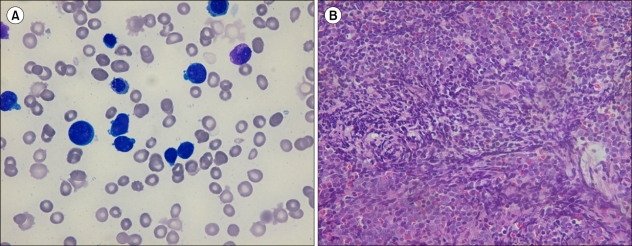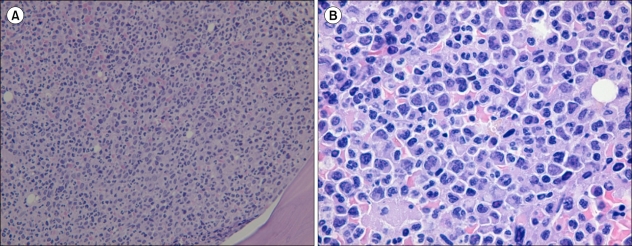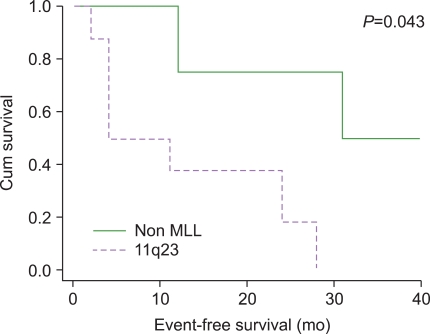Korean J Hematol.
2010 Sep;45(3):177-182. 10.5045/kjh.2010.45.3.177.
Therapy-related acute leukemia in breast cancer patients: twelve cases treated with a topoisomerase inhibitor
- Affiliations
-
- 1Department of Laboratory Medicine, University of Ulsan College of Medicine and Asan Medical Center, Seoul, Korea. hschi@amc.seoul.kr
- 2Department of Internal Medicine, University of Ulsan College of Medicine and Asan Medical Center, Seoul, Korea.
- KMID: 2252059
- DOI: http://doi.org/10.5045/kjh.2010.45.3.177
Abstract
- BACKGROUND
Therapy-related myeloid neoplasm (t-MN) is a distinct class of acute myeloid leukemia (AML) in the World Health Organization (WHO) classification. Both AML and acute lymphoblastic leukemia (ALL) may develop after treatment for primary cancer. Topoisomerase inhibitors are commonly used to treat breast cancer patients and are well-known for their effect on leukemogenesis of therapy-related acute leukemias (t-AL).
METHODS
We retrospectively evaluated bone marrow test results, chromosomal findings, and clinical characteristics of 12 patients who received topoisomerase inhibitors for breast cancer treatment and later developed acute leukemia.
RESULTS
Fourteen patients (0.2%) developed t-AL after treatment for breast cancer. Topoisomerase inhibitors were administered to 12 patients. Among them, 9 patients (75%, 9/12) were diagnosed with therapy-related AML (t-AML) and 3 patients (25%, 3/12) with therapy-related ALL (t-ALL). Eight patients (67%, 8/12) showed translocation involving 11q23 and 3 different partner genes, 19p13.1 (37.5%, 3/8), 9p22 (37.5%, 3/8), and 4q21 (25%, 2/8). The median interval between completion of chemotherapy for breast cancer and occurrence of t-AL was 25 months. Patients with 11q23 translocation showed markedly poorer event-free survival than the group without involvement of 11q23.
CONCLUSION
The incidence rate of t-AL after treatment for breast cancer was 0.2% in a tertiary hospital in Korea. Translocation involving the MLL gene was frequently found in t-AL caused by a topoisomerase inhibitor and was related to poor prognosis.
MeSH Terms
Figure
Cited by 2 articles
-
Therapy-Related Myeloid Neoplasms in 39 Korean Patients: A Single Institution Experience
Hee Jae Huh, Soo Hyun Lee, Keon Hee Yoo, Ki Woong Sung, Hong Hoe Koo, Kihyun Kim, Jun-Ho Jang, Chulwon Jung, Sun-Hee Kim, Hee-Jin Kim
Ann Lab Med. 2013;33(2):97-104. doi: 10.3343/alm.2013.33.2.97.Evaluation of prognostic factors in patients with therapy-related acute myeloid leukemia
Sang Hyuk Park, Hyun-Sook Chi, Young-Uk Cho, Seongsoo Jang, Chan-Jeoung Park
Blood Res. 2013;48(3):185-192. doi: 10.5045/br.2013.48.3.185.
Reference
-
1. Leone G, Fianchi L, Pagano L, Voso MT. Incidence and susceptibility to therapy-related myeloid neoplasms. Chem Biol Interact. 2010; 184:39–45. PMID: 20026017.
Article2. Vardiman JW, Thiele J, Arber DA, et al. The 2008 revision of the World Health Organization (WHO) classification of myeloid neoplasms and acute leukemia: rationale and important changes. Blood. 2009; 114:937–951. PMID: 19357394.
Article3. Leone G, Pagano L, Ben-Yehuda D, Voso MT. Therapy-related leukemia and myelodysplasia: susceptibility and incidence. Haematologica. 2007; 92:1389–1398. PMID: 17768113.
Article4. Smith RE, Bryant J, DeCillis A, Anderson S. Acute myeloid leukemia and myelodysplastic syndrome after doxorubicin-cyclophosphamide adjuvant therapy for operable breast cancer: the National Surgical Adjuvant Breast and Bowel Project Experience. J Clin Oncol. 2003; 21:1195–1204. PMID: 12663705.
Article5. Statistics of cancer reported by national cancer information center. 2006-2007. Accessed July 21, 2010. Seoul, Korea: national cancer information center;at http://www.cancer.go.kr/cms/statics/incidence/index.html.6. Cho J, Hur M, Moon HW, Yun YM, Lee CH, Lee HG. A case of therapy-related ALL with MLL gene rearrangement following treatment of breast cancer. Korean J Lab Med. 2010; 30:255–259. PMID: 20603585.
Article7. Shaffer LG, editor. An International System for Human Cytogenetic Nomenclature. 2009. Basel, Switzerland: ISCN.8. Harper DP, Aplan PD. Chromosomal rearrangements leading to MLL gene fusions: clinical and biological aspects. Cancer Res. 2008; 68:10024–10027. PMID: 19074864.
Article9. 11q23 rearrangements in therapy related leukaemias. 1998. Accessed July, 20, 2010. Poitiers, France: Atlas Genet Cytogenet Oncol Haematol;at http://AtlasGeneticsOncology.org/Anomalies/11q23secondLeukID1131.html.10. Chen W, Wang E, Lu Y, Gaal KK, Huang Q. Therapy-related acute lymphoblastic leukemia without 11q23 abnormality: report of six cases and a literature review. Am J Clin Pathol. 2010; 133:75–82. PMID: 20023261.11. Krivtsov AV, Armstrong SA. MLL translocations, histone modifications and leukaemia stem-cell development. Nat Rev Cancer. 2007; 7:823–833. PMID: 17957188.
Article12. MLL (myeloid/lymphoid or mixed lineage leukemia). 2005. Accessed July 20, 2010. Poitiers, France: Atlas Genet Cytogenet Oncol Haematol;at http://AtlasGeneticsOncology.org/Genes/MLL.html.13. MLLT3 (myeloid/lymphoid or mixed-lineage leukemia (trithorax homolog, Drosophila); translocated to, 3). 1997. Accessed July 20, 2010. Poitiers, France: Atlas Genet Cytogenet Oncol Haematol;at http://AtlasGeneticsOncology.org/Genes/AF9.html.14. ELL (eleven nineteen lysin rich leukemia gene). 2003. Accessed July 20, 2010. Poitiers, France: Atlas Genet Cytogenet Oncol Haematol;at http://AtlasGeneticsOncology.org/Genes/ELL.html.15. AFF1 (AF4/FMR2 family, member 1). 2002. Accessed July 20, 2010. Poitiers, France: Atlas Genet Cytogenet Oncol Haematol;at http://AtlasGeneticsOncology.org/Genes/AF4.html.16. Dührsen U. Therapy-induced leukemia - an underestimated complication of antineoplastic chemotherapy? Zentralbl Gynakol. 2005; 127:235–241. PMID: 16037905.17. Seedhouse C, Russell N. Advances in the understanding of susceptibility to treatment-related acute myeloid leukaemia. Br J Haematol. 2007; 137:513–529. PMID: 17539774.
Article18. Guillem V, Tormo M. Influence of DNA damage and repair upon the risk of treatment related leukemia. Leuk Lymphoma. 2008; 49:204–217. PMID: 18231906.
Article19. Bolufer P, Collado M, Barragan E, et al. Profile of polymorphisms of drug-metabolising enzymes and the risk of therapy-related leukaemia. Br J Haematol. 2007; 136:590–596. PMID: 17367411.
Article20. Martin MG, Welch JS, Luo J, Ellis MJ, Graubert TA, Walter MJ. Therapy related acute myeloid leukemia in breast cancer survivors, a population-based study. Breast Cancer Res Treat. 2009; 118:593–598. PMID: 19322652.
Article21. Praga C, Bergh J, Bliss J, et al. Risk of acute myeloid leukemia and myelodysplastic syndrome in trials of adjuvant epirubicin for early breast cancer: correlation with doses of epirubicin and cyclophosphamide. J Clin Oncol. 2005; 23:4179–4191. PMID: 15961765.
Article22. Kaplan HG, Malmgren JA, Atwood M. Leukemia incidence following primary breast carcinoma treatment. Cancer. 2004; 101:1529–1536. PMID: 15378478.
Article23. Park DJ, Koeffler HP. Therapy-related myelodysplastic syndromes. Semin Hematol. 1996; 33:256–273. PMID: 8819235.
- Full Text Links
- Actions
-
Cited
- CITED
-
- Close
- Share
- Similar articles
-
- Seven Cases of Secondary Acute Leukemia Following Therapy of Breast Cancer
- Four cases of therapy-related leukemia
- Chromosomal Abnormalities at 11q23 after Topoisomerase II Inhibitor Treatment: A Report of Three Cases
- Giant Breast Involvement in Acute Lymphoblastic Leukemia: MRI Findings
- Precursor B-Cell Acute Lymphoblastic Leukemia in Two Patients with a History of Cytotoxic Therapy




